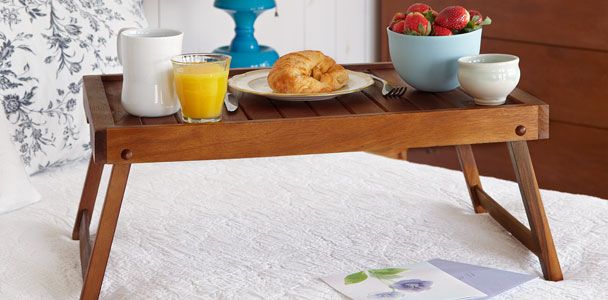Building your own folding serving tray is a cheap project that’s great for beginner woodworkers. It’s perfect for breakfast in bed or your next picnic in the park and only requires basic skills. Our guide will walk you through each step to build a custom, practical, and attractive folding serving tray.
Folding Serving Tray Materials and Tools
Before starting construction, gather all necessary materials and tools. For this project, we used inexpensive oak scants and slats stocked near the hardwood moldings in home centers.
Download the cut list to build the folding serving tray here.
Necessary Hardware
- Brads for securing the tray frame
- Four 1/4-by-1 1/2-inch machine screws to secure the legs to the tray
- Four 1/4-inch nylon washers to place between the legs and the tray
- Four 1/4-inch metal washers to place between the machine-screw nut and tray leg
- Four 1/4-inch lock nuts
- Food-safe finish, such as mineral oil or shellac
- Wood glue
- Wood stain
Tools You’ll Need
- 1/2-inch spade bit
- 1/8-inch and 3/8-inch drill bits
- 60-grit and 220-grit sandpaper
- Brad nailer
- Drill/driver
- Lint-free cloth
- Miter saw
- Paintbrush
- Straight router bit with 1/4 inch shank
- Tape measure
Preparing Your Workspace and Materials
Before you begin construction, set up your workspace. Find a well-ventilated area with ample room. Clear a flat surface, such as a workbench or sturdy table, to serve as your primary work area. We recommend a space with good lighting so you can see details clearly.
Then, organize your tools and materials before diving in. Group similar items together and keep tools within reach. Take time to inspect your wood pieces for any defects or warping. Sand down any rough spots on the oak scants and slats using 60-grit sandpaper.
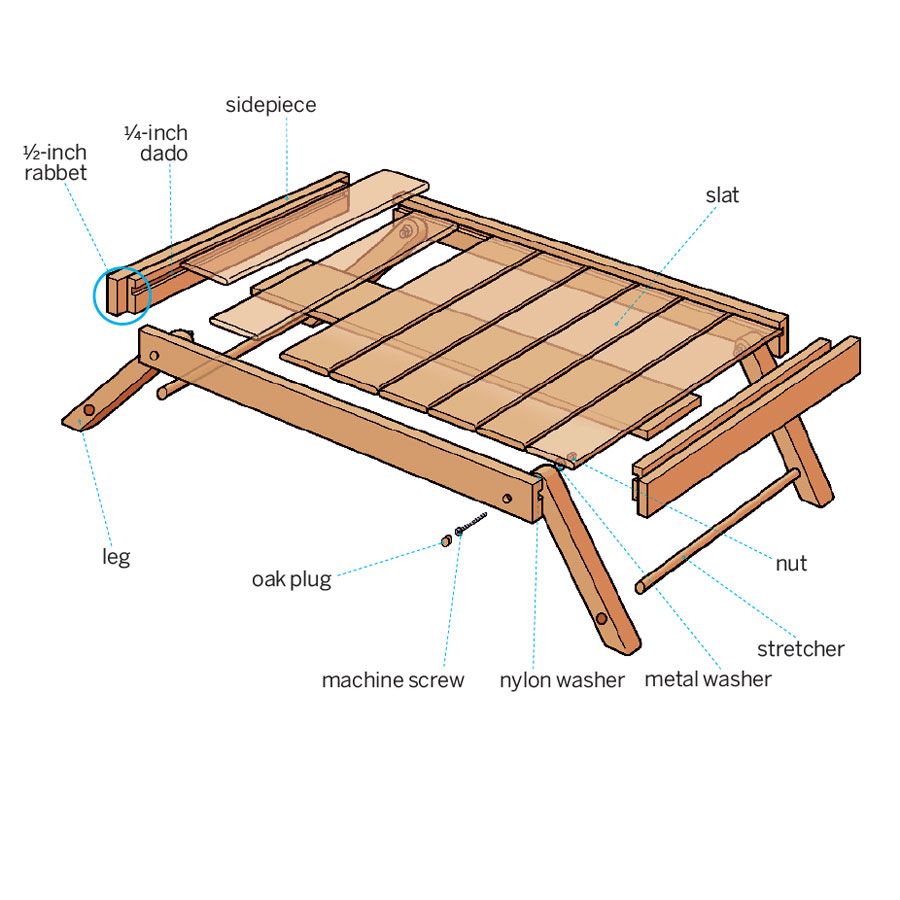
Cutting and Shaping the Tray Frame
The frame forms the foundation of your serving tray, so be precise when you’re cutting and shaping for a sturdy result.
Cutting the Frame Pieces
Begin by using your miter saw to cut the oak scants according to the measurements in your cut list. For the sides of the frame, you’ll need to create a double-thick piece. To do this, glue the shorter piece to the inner face of the longer one, leaving a 1/2-inch rabbet at each end. This rabbet will later accommodate the front and back pieces of the frame.
Check that your cuts are clean and square. Any inaccuracies at this stage can lead to alignment issues later in the project. After cutting, lightly sand the cut edges to remove any splinters or roughness.
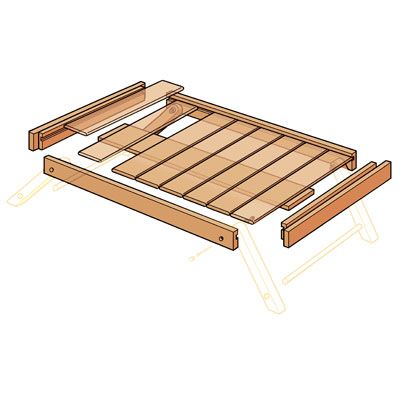
Creating Grooves for the Slats
The next step is to cut grooves along the inside of each frame piece to hold the slats. This process requires careful attention to detail and a steady hand. Here’s how to proceed:
- Lay the frame pieces face up on your workbench.
- Pair the double-thick side pieces together and the thinner front and back pieces together.
- Secure these pairs between lumber scraps of the same thickness, screwing the scraps to the table to hold the frame pieces in place.
- Using a straightedge and a router with a 1/4-inch straight bit, cut a square groove (dado) 1/4 inch from the top of each frame piece along the inside of each frame piece.
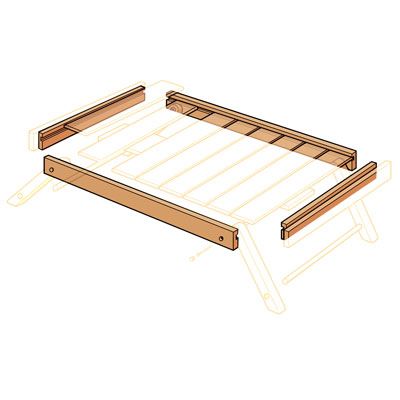
Assembling the Tray Base
With your frame pieces cut and grooved, you’re ready to bring your tray base together. This stage is where your project starts to take shape, and attention to detail will pay off in the final product.
Installing the Slats
The slats not only provide the surface for your tray but also contribute to its overall look. Take care to align the slats evenly for a professional look. Follow these steps to install them properly:
- Use 60-grit sandpaper and a sanding block to ease the long edges of each slat. This step will prevent splinters and create a smoother surface.
- Begin fitting the slats into the grooves you cut earlier. Start at one end and work your way across, ensuring each slat is snug against the next.
- Once all slats are in place, fit the end pieces to the assembly.

Securing the Frame
With the slats in place, it’s time to secure the frame:
- Apply wood glue to the corners where the frame pieces meet.
- Use a brad nailer with 1-inch brads to tack the corners together. This step provides additional strength to the glued joints.
- For extra support, glue a supporting slat along the midline underneath the tray.
Crafting and Attaching the Folding Legs
The folding legs make this serving tray truly versatile. They allow the tray to stand securely on various surfaces and fold away for easy storage.
Shaping the Legs
Start by shaping the legs from the 3/4-inch oak square dowel:
- Cut four pieces to the desired length for your tray legs.
- Round the tops of the legs with 60-grit sandpaper for a smooth finish.
- Drill a 1/4-inch hole an inch from the bottom of each leg. These holes will be used to join the legs with dowels.
The rounded tops of the legs will provide a more comfortable grip when folding and unfolding the tray. Take care to sand evenly to maintain the legs’ symmetry.
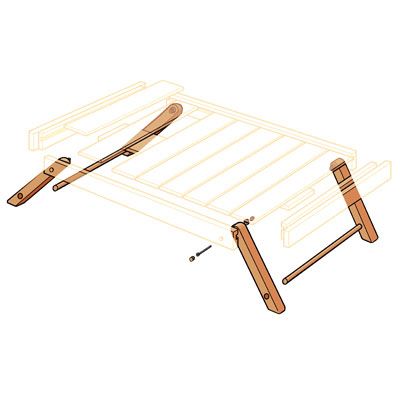
Installing the Leg Mechanism
Attaching the legs requires precision to make sure they fold smoothly:
- Use dowels and glue to join the legs in pairs, creating two U-shaped units.
- With a 1/2-inch spade bit, bore holes 1/4 inch deep into the frame’s outer face, 1 1/2 inches in from the corners.
- Drill through the center of each hole with a 1/8-inch bit.
- Make matching holes half an inch from the top of each leg.
- Attach the legs to the frame using nylon washers and machine screws. The washers will help the legs move smoothly.
- Cap the holes with oak plugs for a finished look.
Test the folding mechanism to check that the legs move freely and lock into place when extended. Adjust the tightness of the screws if necessary to achieve the right balance between stability and easy movement.
Finishing Touches for Your Serving Tray
The final steps in creating your folding serving tray involve refining the surface and applying a protective finish. These touches will enhance the project’s appearance and durability.
Sanding and Smoothing
Begin by giving your tray a thorough sanding:
- Start with 60-grit sandpaper to smooth out any remaining rough spots or unevenness.
- Progress to 220-grit sandpaper for a fine, smooth surface.
- Pay special attention to the edges and corners, ensuring they’re smooth to the touch.
- Use a tack cloth to remove all dust particles after sanding.
A well-sanded surface looks better and provides a better base for staining and finishing.
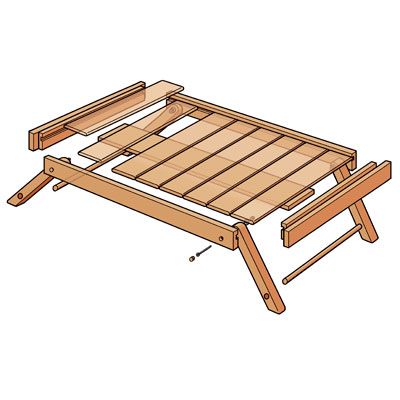
Applying Stain and Food-Safe Finish
The final aesthetic and protective layers add to the lifespan of your tray:
- Apply your chosen wood stain according to the manufacturer’s instructions. This will enhance the natural beauty of the oak.
- Allow the stain to dry completely.
- Once dry, seal the wood with a food-safe finish such as mineral oil or shellac. This step protects the wood from spills and makes cleaning easier.
- For the best protection, apply multiple thin coats of finish, allowing each coat to dry before applying the next.
Remember, the finish you choose will come into contact with food, so make sure you use a safe product for this purpose. Mineral oil is an excellent choice, as it’s completely food-safe and easy to reapply as needed.
Customizing Your Folding Serving Tray
Your folding serving tray doesn’t have to be limited to the basic design. There are numerous ways to personalize it to fit your style or specific needs:
- Experiment with different wood types for varied grain patterns and colors.
- Add decorative elements like carved designs or inlays to the frame or slats.
- Paint the tray instead of staining for a more vibrant look.
- Attach handles to the sides for easier carrying.
- Consider adding a lip around the edge to prevent items from sliding off.
For a unique touch, you could even incorporate elements from other furniture projects. For instance, you might draw inspiration from techniques used to build a window seat and add cushioning to your tray for added comfort when used on your lap.
Serving Tray Maintenance and Care
Here are some maintenance and care tips to keep your folding tray in the best condition possible:
- Clean the tray after each use with a damp cloth and mild soap if necessary.
- Avoid soaking the tray in water or putting it in the dishwasher.
- Periodically reapply food-safe oil to maintain the wood’s moisture and appearance.
- Check and tighten the hardware regularly to keep the folding mechanism working smoothly.
- Store the tray in a dry place to prevent warping or mold growth.
